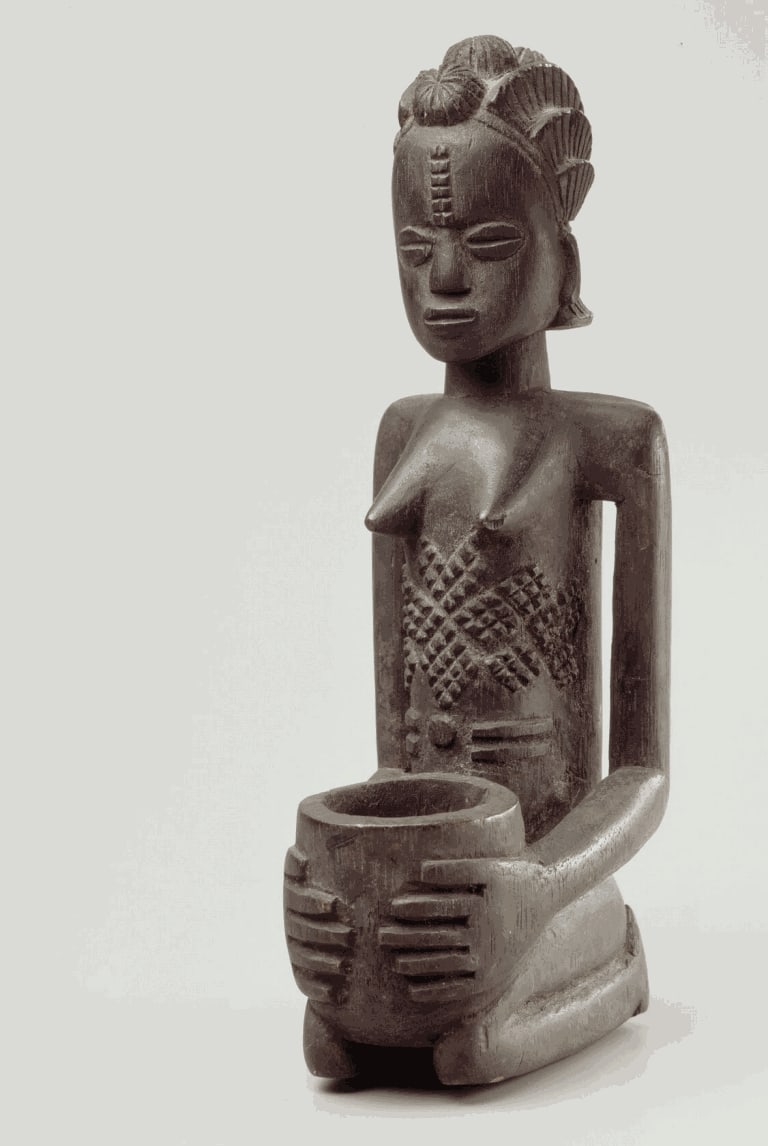A book I’ve been enjoying this summer is “Sanamu. Adventures in search of African Art” by Robert Dick-Read and published in 1964. In the early 1960s, Dick-Read traveled to the Luba in D.R. Congo in search for art. He stayed with Harold Womersley on the outskirts of Kamina. This English missionary had been in the region since 1924. Attracted to the region by the fame of Luba sculpture, Dick-Read inquired with Womersley where the best places to search for it would be. The missionary’s reply is rather interesting:
“I am afraid you are going to be very disappointed. I know of not one single Luba artist in the whole of this huge territory. In the olden days, of course, there were certainly some excellent artists and craftsmen. But I fear that since the coming of this civilisation of ours, all that sort of thing has gone. In fact, let me tell you the story of a thing that happened to me when I was running our mission at Kabango. Kabongo was then the capital of the Luba king of the same name (who died in 1948), so if there were any artists anywhere in Lubaland, that is where they would have been living. The great chiefs, the paramount especially, were always the one who sponsored the arts, as you know. Well, there was one artist, an old man who is dead now, who used to live and work in a small village near Kabongo. One day he came to see me at the mission in a dreadful panic. Some people, he said, had tried to kill him, and he wanted me to protect him. The old chap was very distraught, and I thought he was exaggerating his story, so I quietened him down, and send him back to his village. I couldn’t really see any reason why anyone would want to kill him. But not long after that, exactly the same thing happened again; but this time he resolutely refused to leave the mission. He said he was lucky to have escaped as it was, and if he went back to his village he would surely be killed. So I gave him a bed, and over the next few days made some enquiries as to why anyone should want to kill him. What I heard was this. A number of young men in his and a neighbouring village, seeing him sitting outside his hut whittling away at his wood, began to wonder where this man got his knowledge and skill. The only conclusion they could come to was that he must be in league with the devil; and those in league with the devil deserved to die. We kept him in the mission for several years, and he did some excellent work … ” Mr. Womersley went over to a cupboard and took out a headrest, some combs, and several elaborate hatpins such as the Luba men used to wear. They were beautifully carved in the old tribal style. “But as far as I know”, he went on, “he was the last Luba artist or craftsman in the country”.
The name of this artist unfortunately remains unmentioned. However, next to this paragraph in Dick-Read’s book we find a schematic drawing of a Luba hairpin. Yours truly was able to find an almost identical hairpin in the collection of the Royal Museum for Central Africa (cf. infra). In fact, very little wooden hairpins of the Luba are known, and, almost all of them appear to have been sculpted by the same artist – our master! The few hairpins by him I’ve come across through the years never had any patina, with the wood untouched. The above anecdote by Womersley thus finally explains the context of their creation!

And a more complex example, also without any signs of usage:

Womersley thus firsthand witnessed the changing attitudes towards traditional artists in the Congo of the 1940s. If it wasn’t for his protection, our dear old sculptor surely wouldn’t have survived a third attempt on his life. The mission station of the Womersleys was a popular rest stop for many travellers in the region, so the wood carver surely had a clientele for his sculptures in the later years of his career.
But wait, this anecdote gets even more interesting. In fact, in his book “Luba. To the sources of the Zaire”, François Neyt identifies this artist as Kiloko, who lived in Busangu, fifty miles from Kamina – so we do have his name! Typical morphological features are the complex coiffure (which for Neyt corresponds to the fashion of the 1920s), the double vertical line of keloid scarifications on the forehead, the coffee bean-shaped eyes, the triangular shaped nose and the oval mouth. Womersley’s statement that the artist sculpted different types of objects can be confirmed as indeed headrests, friction oracles, and bowl bearers, can be identified that can be positively attributed to this master carver. Below some examples of works in his easily recognisable style.
 Luba bowl-bearer. Height: 26,5 cm. Collection Royal Museum for Central Africa, Tervuren, #EO.0.0.37053.
Luba bowl-bearer. Height: 26,5 cm. Collection Royal Museum for Central Africa, Tervuren, #EO.0.0.37053. Luba headrest. Height: 15 cm. Collection Royal Museum for Central Africa, Tervuren, #EO.1955.77.2.
Luba headrest. Height: 15 cm. Collection Royal Museum for Central Africa, Tervuren, #EO.1955.77.2.
So, you wonder, what happened to our dear treasure hunter, Robert Dick-Read ? Well, he continues.. “I stayed with the Womersleys for a day or two; then, feeling very depressed, once again got back on the road and headed north toward the land of the Bushongo where I hoped my luck would be better..”